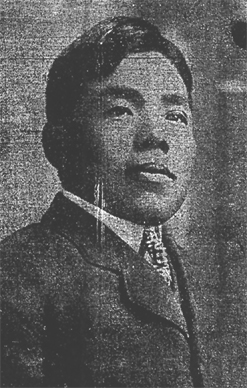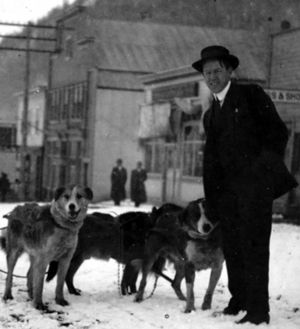Jujiro Wada facts for kids
Jujiro Wada (Japanese: Wada Jujiro) (born around 1872 – died March 5, 1937) was a Japanese adventurer and businessman. He became famous for his exciting journeys in Alaska and the Yukon Territory around the early 1900s.
Contents
Early Adventures
Jujiro Wada had an interesting start to his life. He often said he was born in Ehime Prefecture, Japan, on February 12, 1872. He claimed his family was wealthy and that he came to San Francisco in 1891 to study at Yale University.
However, a researcher named Yuji Tani found a different story. Tani believes Wada was born on January 6, 1875, in Komatsu, Ehime Prefecture. His father was a former samurai who had lost his fortune. When Jujiro was four, his father died. Jujiro and his mother then moved to live with relatives in what is now Matsuyama City.
When he was about 12 or 13 years old, Jujiro started working at a paper factory. Later, in 1890, he worked for a transport company. During this time, he heard many exciting stories about the amazing wealth in America.
Records show Wada took a steamship to San Francisco in March 1890. But Wada himself said he secretly boarded a ship from Kobe in 1891.
Life as a Whaler
From March 1892 to October 1894, Wada worked as a cabin boy and cook on a whaling ship called the Balaena. This ship hunted large baleen whales in the North Pacific Ocean and Arctic Ocean. During this time, Wada learned to speak English from the ship's captain, H. Havelock Norwood.
In 1895, Wada returned to Alaska. This time, he was a shore hunter in Utqiagvik. Shore hunters used small boats from land to catch whales. They also hunted caribou to provide food for visiting whale ships. Wada worked for the Cape Smythe Whaling and Trading Company. This is likely where he learned to handle sled dogs and speak some of the local Alaska Native languages.
In 1896, Wada went back to Japan for about three months to visit his mother. After his visit, he returned to Alaska and continued working as a shore whaler in Utqiagvik. In September 1897, an early freeze trapped eight whaling ships in the ice near Point Barrow. Wada and other local whalers helped the crews of these stranded ships.
Becoming a Prospector and Cook
Wada was in San Francisco during 1898 and 1899. Years later, in 1914, a young girl named Helen Wada Silveira from San Francisco wrote to the postmaster in Fairbanks. She claimed to be Wada's daughter. When Wada heard about her, he replied, calling her "Himeko." Today, her many children and their families live across Northern California.
In 1901, Wada was in Nome. He likely spent the winter of 1901-1902 in Seattle. On May 26, 1902, he arrived in Skagway by steamer from Seattle.
From Skagway, Wada took another ship to St. Michael. Then, he traveled up the Koyukuk River in a small boat. In August 1902, Wada got a job as a cook for E.T. Barnette. Barnette had set up a trading post on the Chena River. This spot later grew into the city of Fairbanks.
Fairbanks Gold Rush
On December 28, 1902, Wada drove one of Barnette's dog teams to Dawson City. His mission was to tell the Canadians about the recent gold discoveries near Fairbanks. A reporter wrote a front-page story with the headline "Rich Strike Made in the Tanana."
This news made hundreds of miners leave Dawson City for Fairbanks. However, many were disappointed when they arrived. Prices were very high, and the best gold sites were already claimed. An angry crowd gathered near Barnette's store. They threatened both Barnette and Wada.
Facing Challenges
After this difficult experience, Wada left Fairbanks for Nome. In July 1903, he faced some legal trouble regarding the sale of animal furs. He paid a fine and left town.
During the winter of 1904-1905, Wada hunted seals along the Beaufort Sea with some Native companions. In August 1906, he was back in Nome. He faced more legal issues there but was found innocent. He continued to deal with court matters for the rest of that year.
Marathon Runner
To earn money for his legal costs, Wada started running indoor marathon races. These races were often gambling events with large cash prizes. Wada was a good runner and won a marathon in Nome in March 1907.
In August 1907, Wada traveled to Vancouver, British Columbia. The local newspaper reported that Wada was a great storyteller. One of his favorite tales was about how he trained two polar bear cubs to pull his sled!
After a month in Vancouver, Wada returned to Dawson City. He got a dog team and drove to Rampart, Alaska, to look for gold. He visited whalers staying for the winter at Herschel Island in March 1908. He left them a few days later and returned to Dawson City. On this trip, Wada reportedly ran out of dog food and fed his sealskin pants to his dogs. He said it was warm enough that he didn't suffer too much from the cold. After claiming some mining sites and buying new clothes, Wada took several steamers to Nome.
Wada left Nome on December 18, 1908, and arrived in Fairbanks on January 11, 1909. This meant his dog team traveled about 35 miles each day! He was rushing for an indoor marathon scheduled for January 15, 1909. Wada finished second in that race.
Wada planned to run in Fairbanks' Independence Day Marathon on July 1, 1909, but he got sick and could not participate. After he recovered, Wada went south to run in more long-distance races. On October 7, 1909, he ran a 20-mile race in Vancouver, British Columbia, but he lost. He was supposed to run an official marathon in Seattle on October 17, but he did not. The winner of that race set a new world record.
Blazing the Iditarod Trail
Wada left Seattle on November 24, 1909. The Seattle Times newspaper reported his departure. The article said that Wada, dressed in a nice suit, looked more like a businessman than an adventurer. As he boarded the ship, he was recognized by other Alaskans. He turned and said, "Good luck everybody. Follow me and you all will have money."
After arriving in Seward, Wada and three other men – Alfred Lowell, Dick Butler, and Frank Cotter – helped create the famous Iditarod Trail. After finishing this important project, Wada went back to Seattle. From Seattle, he traveled to Louisiana to visit Edward McIlhenny. He likely went there to get money for more expeditions. He returned to Alaska through Seattle in April 1911.
In early 1912, Wada was in the Kuskokwim area. He was searching for a Japanese man known as Allen, who had disappeared there. On March 11, 1912, Wada was in Iditarod. In July 1912, he and his partner, John Baird, found gold on the Tulasak River. Wada took about $12,000 worth of gold with him to Seattle to report his findings to his supporters, who included McIlhenny and the Guggenheim brothers.
Wada returned to Seward in November 1912. He brought two sleds full of mining equipment, other supplies, and four Japanese helpers who would drive dog teams. The Japanese men and their twenty dogs then drove to the Bear Creek gold strike. Wada stayed at the Bear Creek site until February 1913.
Later Years
Wada went to Seattle for a short time, then returned to Alaska in May 1913. That same year, a book called Alaska, an Empire in the Making described him as one of Alaska's best long-distance dog sled drivers.
In 1915, a man wrongly accused Wada of being a Japanese spy. This story appeared again in 1923 and during World War II. In May 1915, Wada was working at a tuna packing plant in San Pedro, California. He left town quickly after getting a phone call. Accounts about Wada are sometimes confusing. In 1916, Wada said the phone call was a job offer in Alaska, and he traveled to New York. However, in a letter to a friend, Wada wrote that he had to leave because he felt unsafe.
During 1917 and 1918, Wada continued to look for gold in the Yukon. In 1919, he went to the Northwest Territories.
On September 6, 1920, he entered New York State near Niagara Falls. He listed his last home as Herschel Island, Northwest Territories. He said he was 5 feet 2 inches tall, with black hair and a dark complexion.
From 1920 to 1923, he trapped foxes and searched for gold and oil in different areas. His business partners during this time included a well-known trader named Poole Field.
Wada left Canada in April 1923. On May 3, 1923, he arrived in Ketchikan aboard a ship. He said he was a citizen of Canada, but he was not allowed into Alaska because he did not have a passport.
His exact movements after this are not fully known. But in 1930, he was in Chicago, Illinois. In May 1934, he was in Seattle, having recently arrived from San Francisco. In January 1936, he was in Green River, Wyoming. During the winter of 1936-1937, he was in Redding, California.
Jujiro Wada died at the San Diego County hospital on March 5, 1937. He passed away from an illness. He was buried at the county's expense, likely in the Mount Hope cemetery. But he was not forgotten, especially in Alaska and the Yukon. In 2007, a Yukon Quest sled dog race was held in his memory.
|




